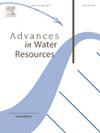FluidNet-Lite:用于非均质多孔介质中多相流孔隙尺度建模的轻量级卷积神经网络
IF 4.2
2区 环境科学与生态学
Q1 WATER RESOURCES
引用次数: 0
摘要
由于计算复杂性和数据稀缺性,非均质多孔介质在两相流体流动过程中的突破模式建模面临着独特的挑战。目前的深度学习方法主要是基于生成对抗网络(GAN)的,主要集中在同质介质上,限制了它们在现实世界非均质孔隙系统中的实际应用。在这项工作中,我们介绍了FluidNet-Lite,一个轻量级的卷积神经网络,用于非均质多孔介质的孔隙尺度建模。从生成任务框架出发,我们将突破模式预测重新定义为创新的逐像素分类任务,显著降低了模型复杂性。通过整合两个基本物理参数——粘度比(M)和接触角(θ),我们的方法提高了预测的准确性,并将关键的基于物理的依赖关系直接嵌入到学习过程中。颗粒加权自适应损失(GWAL)函数进一步强化了流体流动原理,增强了模型与物理定律的一致性。FluidNet-Lite实现了最先进的性能,交叉Union (IoU)为0.92,结构相似指数(SSIM)为0.89。它比基于gan的替代品轻94%,计算效率提高48%,减少了40%的VRAM使用和30%的推理时间。FluidNet-Lite展示了跨插值、外推和未见测试样本的强大泛化,为非均质多孔介质流体动力学的轻量级、物理信息建模设定了新的基准,其优越的性能和效率优于传统方法。我们还发布了一个全面的数据集和代码库,以支持基于深度学习的孔隙尺度非混相驱替模式代理建模的轻量级架构的未来研究。本文章由计算机程序翻译,如有差异,请以英文原文为准。
FluidNet-Lite: Lightweight convolutional neural network for pore-scale modeling of multiphase flow in heterogeneous porous media
Modeling breakthrough patterns in heterogeneous porous media during two-phase fluid flow presents unique challenges due to computational complexity and data scarcity. Current deep learning approaches, primarily generative adversarial network (GAN) based, focus on homogeneous media, limiting their practical application in real-world heterogeneous pore systems. In this work, we introduce FluidNet-Lite, a lightweight Convolutional Neural Network for pore-scale modeling in heterogeneous porous media. Departing from generative task frameworks, we reformulate breakthrough pattern prediction as an innovative pixel-wise classification task, significantly reducing model complexity. By integrating two essential physical parameters—viscosity ratio () and contact angle (), our approach improves predictive accuracy and embeds critical physics-based dependencies directly into the learning process. A Grain-Weighted Adaptive Loss (GWAL) function further enforces fluid flow principles, enhancing model consistency with physical laws. FluidNet-Lite achieves state-of-the-art performance with an Intersection over Union (IoU) of 0.92 and a Structural Similarity Index Measure (SSIM) of 0.89. It is 94% lighter and 48% more computationally efficient than GAN-based alternatives, reducing VRAM usage by 40% and inference time by 30%. Demonstrating robust generalization across interpolation, extrapolation, and unseen test samples, FluidNet-Lite sets a new benchmark for lightweight, physics-informed modeling in heterogeneous porous media fluid dynamics, as evidenced by its superior performance and efficiency improvements over conventional approaches. We also publish a comprehensive dataset and codebase to support future research in lightweight architectures for deep learning-based surrogate modeling of pore-scale immiscible displacement patterns.
求助全文
通过发布文献求助,成功后即可免费获取论文全文。
去求助
来源期刊

Advances in Water Resources
环境科学-水资源
CiteScore
9.40
自引率
6.40%
发文量
171
审稿时长
36 days
期刊介绍:
Advances in Water Resources provides a forum for the presentation of fundamental scientific advances in the understanding of water resources systems. The scope of Advances in Water Resources includes any combination of theoretical, computational, and experimental approaches used to advance fundamental understanding of surface or subsurface water resources systems or the interaction of these systems with the atmosphere, geosphere, biosphere, and human societies. Manuscripts involving case studies that do not attempt to reach broader conclusions, research on engineering design, applied hydraulics, or water quality and treatment, as well as applications of existing knowledge that do not advance fundamental understanding of hydrological processes, are not appropriate for Advances in Water Resources.
Examples of appropriate topical areas that will be considered include the following:
• Surface and subsurface hydrology
• Hydrometeorology
• Environmental fluid dynamics
• Ecohydrology and ecohydrodynamics
• Multiphase transport phenomena in porous media
• Fluid flow and species transport and reaction processes
 求助内容:
求助内容: 应助结果提醒方式:
应助结果提醒方式:


